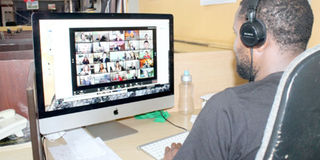Do not make a fool of yourself on video call

As you start the meeting, be aware of your video settings. PHOTO BY KELVIN ATUHAIRE
A few weeks ago, Spanish anchor Alfonso Merlos’ video call went viral.
Viewers of the news cast were shocked to see a naked woman trotting in his background while on a video call in a hotel room.
In our own backyard, Airtel Uganda’s zoom meeting welcomed uninvited guests recently, who disrupted the meeting with obscene images.
There was a lot of confusion, interrupting attention of the listeners.
Many others have also witnessed the same across their online video conferencing meetings.
Video conferencing tools have become popular since the lockdown started as people look for alternatives to continue working.
Owing to the uniqueness of the coronavirus, with effects not foreseen, many were not prepared.
While the country partially eases lockdown, it is anticipated that some aspects of this period, such as video calls will stick around even after lockdown.
Here are some of the things you need to know before jumping onto a video call.
What you need to know
Before you decide to set up a video conference call, it is important to know how many participants you will have and the time you need to effectively communicate.
Video calls are timed and the number of participants can vary across applications with some needing payment if a given threshold is passed.
This will help you decide which application you should use for the call.
In addition, one should choose the application depending on the sensitivity of the information they intend to share.
“You need to understand how secure the application you are going to use is, especially if the information is sensitive,” says Mr Anthony Okiror, Video Teleconference Technician/ user support trainer, United Nations multidimensional intergrated stabilisation mission in Central African Republic (MINUSCA).
There are many video conferencing applications such as Zoom, Microsoft Teams, Skype, Hangouts and BlueJeans among others.
Despite its growing popularity, Zoom has been criticised and sued for fraud over its weak security measures.
After the application has been decided, ensure you have the necessary tools needed for your session.
For instance, a laptop or mobile device with a functional camera and microphone.
“Ensure as a host of the meeting, log in to the meeting at least 30 minutes before the scheduled time. It is important to troubleshoot and make sure everything is okay before the meeting officially starts,” he explains.
Important to note, reliable electricity or battery on your devices as well as internet are essential to video calls.
As you start the meeting, be aware of your video settings.
“Mute your microphone whenever you are not speaking. Even if you are alone in the room. Background noise can be an annoying distraction and stifle any meeting’s flow,” he says adding; “When going to speak, check and see if your microphone is unmuted before delivering a two-minute monologue that no one will hear,” he adds.
Camera positioning also matters.
“Do not position your camera too low, too high or hooked onto a different monitor. Weird camera angles can be very distracting and unflattering during video conference calls,” Mr Okiror warns.
Make sure your camera is at eye level and on the monitor you plan to use for the conference.
In addition, ensure your room is well lit.
“Use natural light from windows or simply turn on the overhead light in the room to brighten up the conference,” he urges.
The laxity of working from home tempts many to engage in a video call with inappropriate dressing conduct.
“I know it can be tempting especially if you work from home to wear a work shirt and athletic shorts. You never know if you are going to have to get up suddenly or if your camera might fall. So, wear clean, professional clothing for your video calls,” he says.
The setting is also a key matter of concern. Ensure your background is not distracting.
It is preferred to take a video call with a closed background such as a corner in the house or near a wall guarded by book shelves.
“Your wall art or decorations should be work-appropriate and your surroundings clean. If your room looks like a college dorm room after a bender, clean it or find a different room. This also includes your desk! Avoid having multiple coffee mugs, dishes and trash on the surface,” he encourages.
If it is your turn to present or ask a question, an introduction is prudent.
Consider something like “Hi it’s Jim, I have a question.”
While several programs will notify you as to who is talking, conference line numbers will not. Therefore, be polite and introduce yourself.
Video conferencing is a communication tool and as such requires as much attention as face to face meetings.
“Do not check or read emails or peruse articles while on the video call. This also includes doing additional work beyond the call. It is easy for other participants to tell if you aren’t fully focused and present during the video call,” he says adding that you should endeavor to look into the camera and not at your reflection in the screen so others feel your full and undivided attention to the meeting.
Security
1. Always ensure that meetings are password-protected.
2. Don’t share meeting information on public platforms.
3. Use host controls to your advantage for example, muting participants microphones in case they have forgotten.
4. Utilise waiting rooms or lobbies, these help you vet the people getting into the meeting as you have to give them authorisation.
5. Notify users if the meeting is being recorded.
6. Disable file transfer features.




